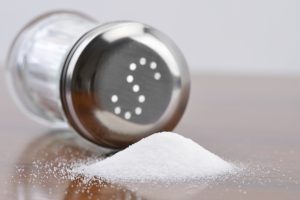Blog

 Eating too much sodium can cause health problems, including high blood pressure and heart disease. Most of us consume around 3,400 milligrams of sodium daily—more than double the 1500 milligrams recommended by the American Heart Association and well above the 2,300 milligrams the CDC recommends for the general population. More than 75% of our sodium comes from processed and restaurant foods. Putting down the salt shaker isn’t enough. Be sure to check the Nutrition Facts label on packages—keep the sodium content below 5% whenever possible. Or, even better, cook more meals at home and be careful about the Salty Six:
Eating too much sodium can cause health problems, including high blood pressure and heart disease. Most of us consume around 3,400 milligrams of sodium daily—more than double the 1500 milligrams recommended by the American Heart Association and well above the 2,300 milligrams the CDC recommends for the general population. More than 75% of our sodium comes from processed and restaurant foods. Putting down the salt shaker isn’t enough. Be sure to check the Nutrition Facts label on packages—keep the sodium content below 5% whenever possible. Or, even better, cook more meals at home and be careful about the Salty Six:
1. Breads and Rolls: Most bread will have 100 to 200 milligrams of sodium per slice. If you are eating a sandwich, those numbers can add up quickly. Find whole-grain bread that has less than 200 milligrams of sodium per serving (usually only 1 slice). Consider switching to whole-grain pita pockets, English muffins or bagel thins, all of which have fewer than 150 milligrams per serving.
2. Cold Cuts and Cured Meats: Just six thin slices of deli meat can add up to half a day’s worth of sodium intake. Ham is especially high in sodium. If you are fond of lunch meats, choose a reduced-sodium variety and eat a small amount. Add veggies to your sandwich to bulk it up.
3. Pizza: Pizza brings together a melting pot of high sodium ingredients: cheese, pepperoni, sausage, tomato sauce and crust. Ask for light cheese and opt for veggie toppings instead of meat. Enjoy 2 small slices, and fill out the meal with salad or steamed vegetables.
4. Poultry: This one can be sneaky! What looks like a natural fresh or frozen piece of chicken could actually be injected with broth or sodium solution preservatives that boost sodium content up to 200 milligrams per serving. Read the label to find a product with low sodium levels. When purchasing chicken, avoid prepared or processed products, which are packed with seasonings and sodium and are often fried. Consider choosing fresh fish once per week to bake or grill as a lower-sodium alternative.
5. Canned Soup or Packaged Soup Mixes: Many prepared soups are a hidden bunker of salt. You can easily blow an entire day’s worth of your allotted sodium intake just by eating a single serving which may contain 600 to 1,000 milligrams per serving (usually only 1 cup). Choose a lower-sodium variety or make your own at home using recipes from Spend Smart. Eat smart.
6. Sandwiches: Burgers and sandwiches are another hidden trove of salt, particularly if the meal comes from a restaurant. It’s extremely difficult to follow a low-sodium diet if you dine out, particularly if you eat at fast food spots where a single sandwich can contain a day’s worth of sodium. Request the burger grilled not fried, without cheese and with condiments on the side (BBQ sauce and ketchup, in particular add sugar and sodium). A better way to go is to share a sandwich and order a fresh side, such as a salad, fruit or low fat yogurt.
Terry Meek
Heart Disease and Stroke Prevention Coordinator
Iowa Department of Public Health

